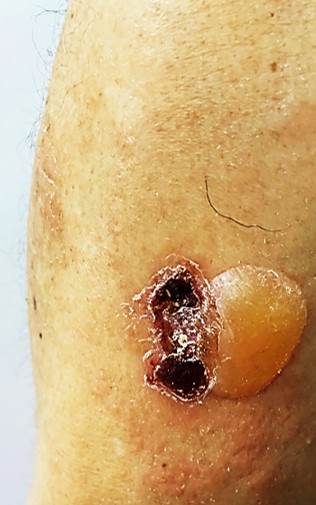[1]
Cantwell AR Jr, Martz W. Idiopathic bullae in diabetics. Bullosis diabeticorum. Archives of dermatology. 1967 Jul:96(1):42-4
[PubMed PMID: 6067557]
[2]
Toonstra J. Bullosis diabeticorum. Report of a case with a review of the literature. Journal of the American Academy of Dermatology. 1985 Nov:13(5 Pt 1):799-805
[PubMed PMID: 3908510]
Level 3 (low-level) evidence
[3]
Larsen K, Jensen T, Karlsmark T, Holstein PE. Incidence of bullosis diabeticorum--a controversial cause of chronic foot ulceration. International wound journal. 2008 Oct:5(4):591-6. doi: 10.1111/j.1742-481X.2008.00476.x. Epub
[PubMed PMID: 19006577]
[4]
Sonani H, Abdul Salim S, Garla VV, Wile A, Palabindala V. Bullosis Diabeticorum: A Rare Presentation with Immunoglobulin G (IgG) Deposition Related Vasculopathy. Case Report and Focused Review. The American journal of case reports. 2018 Jan 15:19():52-56
[PubMed PMID: 29332930]
Level 3 (low-level) evidence
[5]
Arnold L, Vennard KC, Gilbert MP. Bullous Diabeticorum. The Journal of the American Osteopathic Association. 2018 Dec 1:118(12):832. doi: 10.7556/jaoa.2018.178. Epub
[PubMed PMID: 30476996]
[6]
Chiriac A, Costache I, Podoleanu C, Naznean A, Stolnicu S. Bullosis Diabeticorum in a Young Child: Case Report of a Very Rare Entity and a Literature Review. Canadian journal of diabetes. 2017 Apr:41(2):129-131. doi: 10.1016/j.jcjd.2016.10.005. Epub 2016 Dec 21
[PubMed PMID: 28017292]
Level 3 (low-level) evidence
[7]
Gupta V, Gulati N, Bahl J, Bajwa J, Dhawan N. Bullosis diabeticorum: rare presentation in a common disease. Case reports in endocrinology. 2014:2014():862912. doi: 10.1155/2014/862912. Epub 2014 Nov 18
[PubMed PMID: 25478251]
Level 3 (low-level) evidence
[8]
El Fekih N, Zéglaoui F, Sioud A, Fazaa B, Kharfi M, Gaigi S, Kamoun R. [Bullosis diabeticorum: report of ten cases]. La Tunisie medicale. 2009 Nov:87(11):747-9
[PubMed PMID: 20209832]
Level 3 (low-level) evidence
[9]
Bernstein JE, Levine LE, Medenica MM, Yung CW, Soltani K. Reduced threshold to suction-induced blister formation in insulin-dependent diabetics. Journal of the American Academy of Dermatology. 1983 Jun:8(6):790-1
[PubMed PMID: 6863644]
[10]
Huntley AC. Threshold to suction-induced blister formation in insulin-dependent diabetics. Journal of the American Academy of Dermatology. 1984 Feb:10(2 Pt 1):305-6
[PubMed PMID: 6715607]
[11]
Braverman IM, Keh-Yen A. Ultrastructural abnormalities of the microvasculature and elastic fibers in the skin of juvenile diabetics. The Journal of investigative dermatology. 1984 Mar:82(3):270-4
[PubMed PMID: 6699427]
[12]
Lopez PR, Leicht S, Sigmon JR, Stigall L. Bullosis diabeticorum associated with a prediabetic state. Southern medical journal. 2009 Jun:102(6):643-4. doi: 10.1097/SMJ.0b013e3181a506d6. Epub
[PubMed PMID: 19434030]
[13]
Lipsky BA, Baker PD, Ahroni JH. Diabetic bullae: 12 cases of a purportedly rare cutaneous disorder. International journal of dermatology. 2000 Mar:39(3):196-200
[PubMed PMID: 10759959]
Level 3 (low-level) evidence
[14]
Alhadyani A, DeVore A, Gaster E, Elston D. Pediatric patient with linearly distributed bullae. JAAD case reports. 2023 Sep:39():67-69. doi: 10.1016/j.jdcr.2023.06.048. Epub 2023 Jul 17
[PubMed PMID: 37635858]
Level 3 (low-level) evidence
[15]
Grillo VTRDS, Botelho MS, Lange EP, Secanho MS, de Camargo PAB, Miot HA. Bullosis diabeticorum as a differential diagnosis for limb ulcers: case report. Jornal vascular brasileiro. 2022:21():e20210190. doi: 10.1590/1677-5449.202101901. Epub 2022 Sep 9
[PubMed PMID: 36187219]
Level 3 (low-level) evidence
[16]
Wagner G, Meyer V, Sachse MM. [Bullosis diabeticorum : Two case studies]. Der Hautarzt; Zeitschrift fur Dermatologie, Venerologie, und verwandte Gebiete. 2018 Sep:69(9):751-755. doi: 10.1007/s00105-018-4132-7. Epub
[PubMed PMID: 29468278]
Level 3 (low-level) evidence
[17]
Bello F, Samaila OM, Lawal Y, Nkoro UK. 2 Cases of Bullosis Diabeticorum following Long-Distance Journeys by Road: A Report of 2 Cases. Case reports in endocrinology. 2012:2012():367218. doi: 10.1155/2012/367218. Epub 2012 Oct 16
[PubMed PMID: 23119191]
Level 3 (low-level) evidence
[18]
Shahi N, Bradley S, Vowden K, Vowden P. Diabetic bullae: a case series and a new model of surgical management. Journal of wound care. 2014 Jun:23(6):326, 328-30
[PubMed PMID: 24920203]
Level 2 (mid-level) evidence
[19]
Kansal NK, Anuragi RP. Bullous lesions in diabetes mellitus: bullous diabeticorum (diabetic bulla). BMJ case reports. 2020 Aug 27:13(8):. doi: 10.1136/bcr-2020-238617. Epub 2020 Aug 27
[PubMed PMID: 32859620]
Level 3 (low-level) evidence
[20]
Chen Y, Ma Y, Li N, Wang H, Chen B, Liang Z, Ren R, Lu D, Boey J, Armstrong DG, Deng W. Efficacy and long-term longitudinal follow-up of bone marrow mesenchymal cell transplantation therapy in a diabetic patient with recurrent lower limb bullosis diabeticorum. Stem cell research & therapy. 2018 Apr 10:9(1):99. doi: 10.1186/s13287-018-0854-9. Epub 2018 Apr 10
[PubMed PMID: 29631615]
[21]
Taylor SP, Dunn K. Bullosis Diabeticorum. Journal of general internal medicine. 2017 Feb:32(2):220. doi: 10.1007/s11606-016-3802-3. Epub 2016 Jul 11
[PubMed PMID: 27400924]
[22]
Hines A, Alavi A, Davis MDP. Cutaneous Manifestations of Diabetes. The Medical clinics of North America. 2021 Jul:105(4):681-697. doi: 10.1016/j.mcna.2021.04.008. Epub
[PubMed PMID: 34059245]
[23]
Vangipuram R, Hinojosa T, Lewis DJ, Downing C, Hixson C, Salas-Alanis JC, Tyring SK. Bullosis Diabeticorum: A Neglected Bullous Dermatosis. Skinmed. 2018:16(1):77-79
[PubMed PMID: 29551123]
[24]
Zhang AJ, Garret M, Miller S. Bullosis diabeticorum: case report and review. The New Zealand medical journal. 2013 Mar 15:126(1371):91-4
[PubMed PMID: 23793125]
Level 3 (low-level) evidence
[25]
Tunuguntla A, Patel KN, Peiris AN, Zakaria WN. Bullosis diabeticorum associated with osteomyelitis. Tennessee medicine : journal of the Tennessee Medical Association. 2004 Nov:97(11):503-4
[PubMed PMID: 15620205]
[26]
Willcox MJ. Recurrent Blister Formation in Setting of Poorly Managed Diabetes Mellitus. Cureus. 2019 Jun 28:11(6):e5029. doi: 10.7759/cureus.5029. Epub 2019 Jun 28
[PubMed PMID: 31497455]
